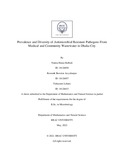Prevalence and diversity of antimicrobial resistant pathogens from medical and community wastewater in Dhaka City
Abstract
Background: Uncontrolled and excessive exposure of antibiotics in the medical waste poses a
selective pressure to acquire and disseminate highly antibiotic resistance genes to common
pathogenic bacteria. This study is aimed to isolate common pathogenic bacteria and prevalence
of multiple drug resistance genes in community and hospital wastewater.
Materials and Methods: Ten different wastewater samples (5 hospitals and 5 community
wastewater) were aseptically collected and bacteriological investigations were performed for
quantification and identification of bacterial isolates. Antibiotic susceptibility was performed by
the Kirby-Bauer disk diffusion method and interpreted using the CLSI guideline. Polymerase chain-reaction (PCR) will be performed for identification of ESBL and carbapenem resistance
genes.
Results: Out of 234 isolates collected (based on different morphology); Gram-negative bacteria
were predominant (85.04%). Top pathogenic-bacteria isolates were E.coli-(15%); Klebsiella
pneumonia (12.82%); Pseudomonas aeruginosa (8.11%); Salmonella sp. (7.26%); Shigella sp.
(6.84%); Staphylococcus aureus (6%). Overall 76.92% isolates were resistant to ampicillin and
34.61%, 40%, 23.08% and 12.39% were resistant to third-generation cephalosporin,
vancomycin, colistin and carbapenem respectively. From overall isolates, the MDR and XDR
organisms were found to be 84.62% and 5.13% respectively. PCR data on ESBL and
carbapenem resistance genes are ongoing.
Conclusion: High prevalence of multiple-drug-resistance bacteria in both hospital and
community wastewater is indicating the dissemination of these pathogens in community which
may lead to great public health issues if the situation is not tackled in near future.

